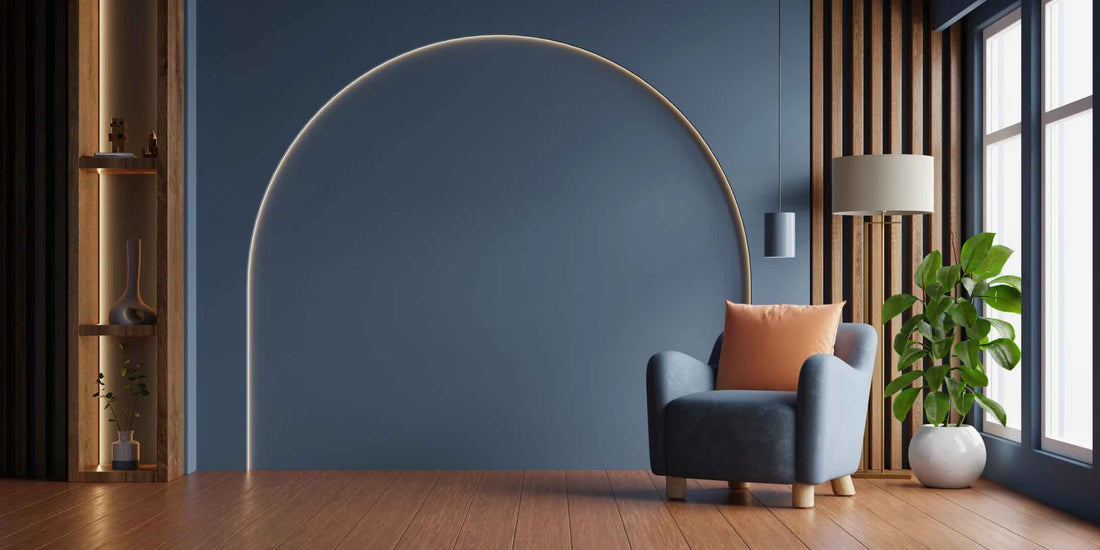
How to Use Accent Walls to Add Personality to a Room
Share
Accent walls are like a room's personal canvas, allowing you to unleash your creativity and make a unique statement. They don’t change the whole outfit, but they make everything look instantly more interesting.
Accent walls have a rich history, but they’ve evolved significantly. No longer are we in the era of random red walls. Today, the magic is in choosing the best accent wall colors that elevate your space, keeping you ahead of the design curve.
This guide walks you through popular accent wall colors, answers “what’s a good color for my accent wall,” and shares insider designer tricks that can make or break the look.
Why Accent Walls Work
Accent walls do something paint alone can’t: they define, highlight, and ground a space. They’re great for:
- Breaking up a large room.
- Adding dimension in small rooms.
- Highlighting architectural features (fireplace, shelving, windows).
- Injecting personality without overwhelming the whole space.
The Secret to Choosing the Right Wall
Choosing the right wall for an accent is not a random decision. As one contractor wisely said, “You don’t just throw color at a wall like spaghetti and hope it sticks.” You need a strategy, and we're here to guide you through it.
The best walls to choose for an accent are usually:
- Behind the bed in a bedroom (instant headboard effect).
- Behind the sofa in a living room (natural focal point).
- Fireplace walls (they’re already a feature—accenting doubles down).
- Dining rooms with one main wall for drama.
- Entryways—a punch of personality right when you walk in.
Pro tip: Avoid walls with too many doors or windows. They break up the color and weaken the impact.
Best Accent Wall Colors
These are the best accent wall colors that interior designers keep returning to.
1. Deep Navy
2. Charcoal Gray
3. Forest Green
4. Terracotta
5. Black
Popular Accent Wall Colors
Trends come and go, but homeowners in 2025 gravitate toward popular accent wall colors that feel grounded yet expressive.
- Sage Green: perfect for living rooms.
- Dusty Blue: Works beautifully in coastal or modern spaces.
- Warm Taupe: This is for those who want a neutral with a little edge.
- Blush Pink: Soft, sophisticated, and surprisingly easy to live with.
- Moody Burgundy: Perfect for dining rooms where you want to set a tone.
Interior designers point out that these shades often draw inspiration from nature—stone, sky, clay, foliage—which makes them more timeless than “trendy.”
What’s a Good Color for My Accent Wall?
Here’s where things get personal. Homeowners often ask: “But seriously, what’s a good color for my accent wall?” The answer depends on three factors:
- Your Room’s Function - Calming tones (sage or navy) are best for bedrooms, while energized hues (terracotta or mustard) work well in kitchens and offices.
- Your Existing Decor—Look around. If your furniture has warm tones, lean into earthy shades. If your palette is cooler (blues, grays), balance with a complementary hue.
- Lighting – North-facing rooms look better with warmer colors. South-facing rooms can handle cooler tones without going icy.
If you’re undecided still, pull a color from your rug, artwork, or throw pillows. It will feel intentional instead of random.
Should You Go Bold or Subtle?
Accent walls don’t always mean bold. Sometimes, the subtlest choices make the most significant impact.
- Bold – Think navy, black, or emerald. Perfect when you want drama and contrast.
- Subtle – Soft beige, greige, or blush. Great for layering textures without too much visual noise.
If you’re particular about your house’s resale value, we suggest you use subtle colors.
Beyond Paint: Creative Accent Wall Ideas
Paint is the obvious choice, but interior designers love experimenting with accent walls beyond color.

- Wallpaper: Textured grasscloth, florals, or geometric prints.

- Wood Slats: Adds depth and a modern architectural touch.

- Stone or Brick Veneer: Rustic, industrial, and long-lasting.

- Two-Tone Paint: Half-wall painting with a chair rail for old-school charm.

- Murals: For those who want a truly one-of-a-kind statement.
These options give contractors and DIYers extra flexibility, especially if they want durability or texture.
How to Balance an Accent Wall
Most homeowners forget the part about balance. The accent wall isn’t the show's star—it’s the supporting actor.
- Keep furniture Simple – If your wall is bold, let your furniture stay neutral.
- Echo the Color Elsewhere – A navy wall feels more intentional if you sprinkle navy pillows or art across the room.
- Watch the Ceilings – Don’t let your accent wall chop the room in half. Pair it with lighter-colored ceilings for an open feel.
Mistakes to Avoid
- Picking a random wall (with doors, windows, or no focal point).
- Going too trendy (neon green will age quickly).
- Forgetting undertones (that “warm beige” may turn peach).
- Ignoring natural light (a color or shade that looks great in the store may look terrible at home).
Your Accent, Your Personality
At the end of the day, accent walls are about personality. They’re permission to be a little bold, to take risks, and to add that layer of character.
